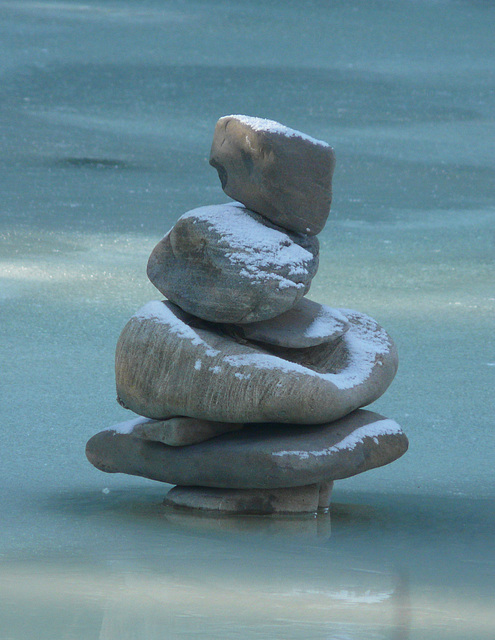Ruffed Grouse
A quick moon shot
Mountain Chickadee
Leafy Rose Cactus
Iced berry
Ruffed Grouse
Great Horned Owl
Red-breasted Nuthatch
Cymbidium Orchids
The old and the new
Stellar's Jay
Mist arising
Great Horned Owl
Morning sun
Stellar's Jay
Peaks in the sun
Gray-crowned Rosy-Finch
Downy Woodpecker
Bleak peaks
Superb Starling
Teething problems
Little House on the Prairie
Mountain Chickadee
Mountain Chickadee
Non-racial
A bad feather day
Sunlit grasses
Should I spit?
.
Love a Llama
Let me out
A mix of colours
On the fence
Floral explosion
Gentleness
Downy Woodpecker
Down on the Ranch
Bald Eagle with Coyote
Tropical
Young Siberian Tiger
Flamingo
Orchid with droplets
Bladder Campion seedpods
Poinsettia
A little too close for comfort
See also...
Keywords
Authorizations, license
-
Visible by: Everyone -
All rights reserved
-
113 visits
Inukshuk


On Monday, 31st December, I took part in the 2007 Christmas Bird Count in the Sheep River/Turner Valley area, south of Calgary. The weather was an absolutely perfect winter's day! At one of the farms we stopped at, the owners had built an Inukshuk (pronounced IN-OOK-SHOOK) "art gallery" on the frozen creek that runs along the back of their home.
"Inukshuk (singular), meaning "likeness of a person" in Inuktitut (the Inuit language), is a stone figure made by the Inuit. The plural is inuksuit. The Inuit make inuksuit in different forms and for different purposes: to show directions to travellers, to warn of impending danger, to mark a place of respect, or to act as helpers in the hunting of caribou. Similar stone figures were made all over the world in ancient times, but the Arctic is one of the few places where they still stand. An inukshuk can be small or large, a single rock, several rocks balanced on each other, round boulders or flat. Inuit tradition forbids the destruction of inuksuit.
Inukshuk in the form of human beings, called inunnguaq, seem to have been a recent development, perhaps only appearing after the arrival of European whalers in the 19th century. One of the most important types of inuksuit are those that helped in the caribou hunt. These are usually built with 2 or 3 rocks piled up and placed in converging lines along the migration route of the herd. The Inuit placed arctic heather among the rocks to simulate human hair. The figures were intended to spook the caribou and stampede them towards the places where the hunters hid.
An open leg on an inukshuk found near water or a coastline may point to an open channel for navigation. If an inukshuk is in open land, a leg or arm might suggest a direction. Inuksuit placed near a lake might show that fish can be found in the lake at the same distance the figure is placed from the shoreline. Some inuksuit were built out of respect for a beloved person and are seen as memorials." From www.thecanadianencyclopedia.com.
"Inukshuk (singular), meaning "likeness of a person" in Inuktitut (the Inuit language), is a stone figure made by the Inuit. The plural is inuksuit. The Inuit make inuksuit in different forms and for different purposes: to show directions to travellers, to warn of impending danger, to mark a place of respect, or to act as helpers in the hunting of caribou. Similar stone figures were made all over the world in ancient times, but the Arctic is one of the few places where they still stand. An inukshuk can be small or large, a single rock, several rocks balanced on each other, round boulders or flat. Inuit tradition forbids the destruction of inuksuit.
Inukshuk in the form of human beings, called inunnguaq, seem to have been a recent development, perhaps only appearing after the arrival of European whalers in the 19th century. One of the most important types of inuksuit are those that helped in the caribou hunt. These are usually built with 2 or 3 rocks piled up and placed in converging lines along the migration route of the herd. The Inuit placed arctic heather among the rocks to simulate human hair. The figures were intended to spook the caribou and stampede them towards the places where the hunters hid.
An open leg on an inukshuk found near water or a coastline may point to an open channel for navigation. If an inukshuk is in open land, a leg or arm might suggest a direction. Inuksuit placed near a lake might show that fish can be found in the lake at the same distance the figure is placed from the shoreline. Some inuksuit were built out of respect for a beloved person and are seen as memorials." From www.thecanadianencyclopedia.com.
- Keyboard shortcuts:
Jump to top
RSS feed- Latest comments - Subscribe to the comment feeds of this photo
- ipernity © 2007-2024
- Help & Contact
|
Club news
|
About ipernity
|
History |
ipernity Club & Prices |
Guide of good conduct
Donate | Group guidelines | Privacy policy | Terms of use | Statutes | In memoria -
Facebook
Twitter

Sign-in to write a comment.